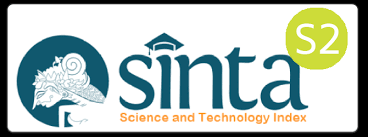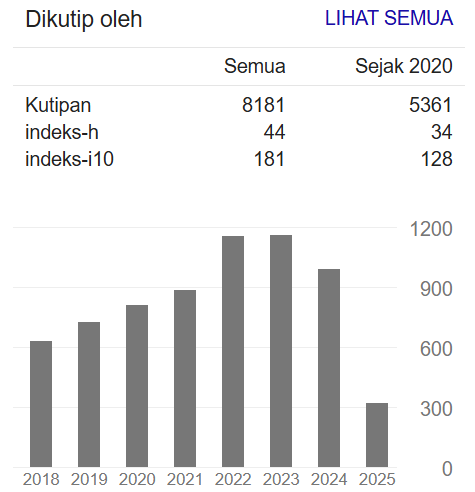FAKTOR-FAKTOR YANG MENENTUKAN PERILAKU PEMERIKSAAN PAYUDARA SENDIRI (SADARI) PADA REMAJA PEREMPUAN
DOI:
https://doi.org/10.34011/jmp2k.v35i1.2551Keywords:
behavior, breast cancer, BSE, factor, teenagersAbstract
In 2022, 2.3 million women were diagnosed with breast cancer worldwide. In 2022, 670,000 women died of breast cancer worldwide. This study aimed to analyze the factors that determine breast self-examination behavior (sadar) in adolescent girls. This study was conducted in the city of Palembang from April to June 2024. The design of this study was cross-sectional. The research team consisted of 18 teams spread to the smallest areas. Data collection used questionnaires and direct observation, with some ratio data categorized to facilitate statistical testing. The population of this study were adolescent girls aged 15-24 years who had both parents, lived with their parents, and were enrolled in high school at the time of data collection (inclusion criteria). The Chi-Square test was used for analysis, with data processing using computerized statistics at a 95% confidence level (α = 0.05). The results of this study indicate that behavior related to breast self-examination (BSE) is influenced by age (p = 0.010), ethnicity p = 0.000), social environment (p = 0.002), internet access (p = 0.011), information media (p = 0.000), family (p = 0.000), and peer influence (p = 0.000). In conclusion, there is a relationship between breast self-examination behavior and age, ethnicity, social environment conditions, internet access, information media, family influence, and peer influence. The implications of the findings of this study are the need to increase information and education regarding the importance of BSE in the early detection of breast cancer, especially for groups that are vulnerable to the disease.
References
WHO, “Breast Cancer,” Geneva, 2022. Accessed: Nov. 17, 2024. [Online]. Available: https://www.who.int/news-room/fact-sheets/detail/breast-cancer
S. Zhang, Z. Jin, L. Bao, and P. Shu, “The global burden of breast cancer in women from 1990 to 2030: assessment and projection based on the global burden of disease study 2019,” Front Oncol, vol. 14, no. 6, pp. 1–13, 2024, doi: 10.3389/fonc.2024.1364397.
S. Łukasiewicz, M. Czeczelewski, A. Forma, J. Baj, R. Sitarz, and A. Stanisławek, “Breast Cancer—Epidemiology, Risk Factors, Classification, Prognostic Markers, and Current Treatment Strategies—An Updated Review,” Cancers (Basel), vol. 13, no. 17, pp. 4287–413, 2021, doi: 10.3390/cancers13174287.
E. Aprilianto, S. A. Lumadi, and F. I. Handian, “Family Social Support and the Self-Esteem of Breast Cancer Patients Undergoing Neoadjuvant Chemotherapy,” J Public Health Res, vol. 10, no. 2, pp. 1–7, 2021, doi: 10.4081/jphr.2021.2234.
Y. S. Prabandari et al., “‘Alas … my sickness becomes my family’s burden’: A nested qualitative study on the experience of advanced breast cancer patients across the disease trajectory in Indonesia,” The Breast, vol. 63, no. 6, pp. 168–176, 2022, doi: 10.1016/j.breast.2022.04.001.
S. H. Hutajulu et al., “Delays in the presentation and diagnosis of women with breast cancer in Yogyakarta, Indonesia: A retrospective observational study,” PLoS One, vol. 17, no. 1, pp. 1–19, 2022, doi: 10.1371/journal.pone.0262468.
O. Ginsburg et al., “Breast cancer early detection: A phased approach to implementation,” Cancer, vol. 126, no. S10, pp. 2379–2393, 2020, doi: 10.1002/cncr.32887.
S. Sumiyati, A. Widiastuti, P. Hastuti, S. P. Winarso, and H. Kurniasih, “Media booklet improve the attitude and practice of breast self-examination as early detection of breast cancer in female students,” Jurnal Aisyah : Jurnal Ilmu Kesehatan, vol. 8, no. 2, pp. 417–422, 2023, doi: 10.30604/jika.v8i2.1942.
N. L. Stout, D. Santa Mina, K. D. Lyons, K. Robb, and J. K. Silver, “A systematic review of rehabilitation and exercise recommendations in oncology guidelines,” CA Cancer J Clin, vol. 71, no. 2, pp. 149–175, 2021, doi: 10.3322/caac.21639.
B. K. Behera, R. Prasad, and Shyambhavee, “Primary health-care goal and principles,” in Healthcare Strategies and Planning for Social Inclusion and Development, Elsevier, 2022, pp. 221–239. doi: 10.1016/B978-0-323-90446-9.00008-3.
T. K. Dewi, R. A. C. Ruiter, R. Ardi, and K. Massar, “The role of psychosocial variables in breast self‐examination practice: Results from focus group discussions in Surabaya, Indonesia,” Psychooncology, vol. 31, no. 7, pp. 1169–1177, 2022, doi: 10.1002/pon.5905.
H. Kumarasamy, A. Veerakumar, S. Subhathra, Y. Suga, and R. Murugaraj, “Determinants of awareness and practice of breast self examination among rural women in Trichy, Tamil Nadu,” J Midlife Health, vol. 8, no. 2, pp. 84–92, 2017, doi: 10.4103/jmh.JMH_79_16.
S. Polishwala, . S., and S. Patankar, “The Assessment and Comparison of the Knowledge of Breast Self-Examination and Breast Carcinoma Among Health Care Workers and the General Population in an Urban Setting,” Cureus, vol. 15, no. 3, pp. 1–12, 2023, doi: 10.7759/cureus.36592.
L. Wang, “Early Diagnosis of Breast Cancer,” Sensors, vol. 17, no. 7, pp. 1572–1582, 2017, doi: 10.3390/s17071572.
K. D. Miller et al., “Cancer treatment and survivorship statistics, 2022,” CA Cancer J Clin, vol. 72, no. 5, pp. 409–436, 2022, doi: 10.3322/caac.21731.
A. Shrestha, C. Martin, M. Burton, S. Walters, K. Collins, and L. Wyld, “Quality of life versus length of life considerations in cancer patients: A systematic literature review,” Psychooncology, vol. 28, no. 7, pp. 1367–1380, 2019, doi: 10.1002/pon.5054.
R. Lindawati and N. Yunarsih, “Faktor-Faktor yang Berhubungan dengan Perilaku Pemeriksaan Payudara Sendiri (SADARI) pada Siswi Kelas XII di SMK Negeri 3 Cilegon Banten,” ProHealth Journal, vol. 18, no. 1, pp. 9–14, 2021, doi: 10.59802/phj.202118198.
N. S. Patui, A. A. Yudiana, B. A. Wandira, and U. Aulia, “Factors Associated with Breast Self-Examination Behavior (BSE) in Young Women,” Journal of Health and Nutrition Research, vol. 2, no. 1, pp. 33–39, 2023, doi: 10.56303/jhnresearch.v2i1.117.
A. González Moreno and M. del M. Molero Jurado, “Healthy Lifestyle in Adolescence: Associations with Stress, Self-Esteem and the Roles of School Violence,” Healthcare, vol. 12, no. 1, pp. 63–75, 2023, doi: 10.3390/healthcare12010063.
A. Magiera and A. Pac, “Determinants of Quality of Life among Adolescents in the Małopolska Region, Poland,” Int J Environ Res Public Health, vol. 19, no. 14, pp. 8616–8626, 2022, doi: 10.3390/ijerph19148616.
Y. Biratu Terfa, E. Bayana Kebede, and A. Olani Akuma, “
Breast Self-Examination Practice Among Women in Jimma, Southwest Ethiopia: A Community-Based Cross-Sectional Study
,” Breast Cancer: Targets and Therapy, vol. 12, no. 10, pp. 181–188, 2020, doi: 10.2147/BCTT.S279148.B. Ohaeri and M. Aderigbigbe, “Knowledge and use of breast self-examination and mammogram among women of reproductive age in Oyo State Secretariat, Ibadan, Oyo State, Nigeria,” Eur J Midwifery, vol. 3, no. 4, pp. 1–7, 2019, doi: 10.18332/ejm/105858.
S. N. Williams, K. Dienes, J. Jaheed, J. K. Wardman, and J. Petts, “Effectiveness of communications in enhancing adherence to public health behavioral interventions: a COVID-19 evidence review,” Philosophical Transactions of the Royal Society A: Mathematical, Physical and Engineering Sciences, vol. 381, no. 2257, pp. 1–12, 2023, doi: 10.1098/rsta.2023.0129.
R. Lidskog, A. Standring, and J. M. White, “Environmental expertise for social transformation: roles and responsibilities for social science,” Environ Sociol, vol. 8, no. 3, pp. 255–266, 2022, doi: 10.1080/23251042.2022.2048237.
saeed bashirian, M. Barati, L. M. Shoar, Y. Mohammadi, and M. Dogonchi, “Factors Affecting Breast Self-examination Behavior Among Female Healthcare Workers in Iran: The Role of Social Support Theory,” Journal of Preventive Medicine and Public Health, vol. 52, no. 4, pp. 224–233, 2019, doi: 10.3961/jpmph.18.277.
Taqi Mohammed Jwad Taher and Firas Turki Rashed Sarray, “Internet as a Source of Information for Breast Cancer Early Detection,” Pakistan Journal of Medical & Health Sciences, vol. 14, no. 2, pp. 1589–1592, 2020.
M. S. Vaghefi, N. Beheshti, and H. Jain, “Dissemination of health messages in online social network: A study of healthcare providers’ content generation and dissemination on Twitter,” Information & Management, vol. 61, no. 2, pp. 103925–103935, 2024, doi: 10.1016/j.im.2024.103925.
S. Kanchan and A. Gaidhane, “Social Media Role and Its Impact on Public Health: A Narrative Review,” Cureus, vol. 15, no. 1, pp. 1–10, 2023, doi: 10.7759/cureus.33737.
J. Chen and Y. Wang, “Social Media Use for Health Purposes: Systematic Review,” J Med Internet Res, vol. 23, no. 5, pp. e17917–e17928, 2021, doi: 10.2196/17917.
M. R. Hoehe and F. Thibaut, “Going digital: how technology use may influence human brains and behavior ,” Dialogues Clin Neurosci, vol. 22, no. 2, pp. 93–97, 2020, doi: 10.31887/DCNS.2020.22.2/mhoehe.
M. Paul, L. Maglaras, M. A. Ferrag, and I. Almomani, “Digitization of healthcare sector: A study on privacy and security concerns,” ICT Express, vol. 9, no. 4, pp. 571–588, 2023, doi: 10.1016/j.icte.2023.02.007.
C. O’Regan, B. Brady, C. Connolly, P. Dolan, and G. MacRuairc, “Blending the Formal and Nonformal Educational Sectors: Creating a Shared Learning Initiative for Secondary School Teachers and Youth Workers,” Child Youth Serv, vol. 4, no. 7, pp. 1–24, 2023, doi: 10.1080/0145935X.2023.2236940.
A. Haleem, M. Javaid, M. A. Qadri, and R. Suman, “Understanding the role of digital technologies in education: A review,” Sustainable Operations and Computers, vol. 3, no. 2, pp. 275–285, 2022, doi: 10.1016/j.susoc.2022.05.004.
M. M. H. G. Hendrickx, L. G. Kos, A. H. N. Cillessen, and T. Mainhard, “Reciprocal associations between teacher-student relations and students’ externalizing behavior in elementary education? A within-dyad analysis,” J Sch Psychol, vol. 90, no. 2, pp. 1–18, 2022, doi: 10.1016/j.jsp.2021.10.004.
R. W. Blum, J. Lai, M. Martinez, and C. Jessee, “Adolescent connectedness: a cornerstone for health and wellbeing,” BMJ, vol. 1, no. 10, pp. e069213–e069223, 2022, doi: 10.1136/bmj-2021-069213.




